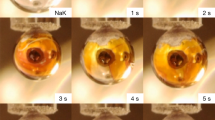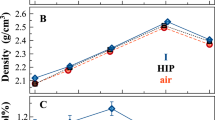Abstract
MEASUREMENTS of the chemical effects of colour centres have previously been made on additively coloured crystals1,2 and on crystals irradiated with X-rays3,4. The usual method of measuring electron-excess centres has been to follow the change of pH which occurs on dissolving the crystals in water, due to the reaction e + H2O = ½H2 + OH−. This method is subject to errors due to the variable carbon dioxide content of solutions, and large effects have been reported with untreated material2. We have found that measurement of the gas evolved on dissolution of a treated crystal in carefully degassed water can be used successfully. Analysis of the gas in a Blacet–Leighton micro-apparatus always revealed 95–99 per cent hydrogen present. This method entails no uncertainties due to solution effects, and blank results were always obtained with untreated crystals. It can be applied most easily to concentrations of centres in the region of 1018 per cm.3 produced either by additive coloration or by ionizing radiation. Direct comparison of this chemical effect with the optical absorption of the F-band in additively coloured crystals is difficult at these concentrations, since very thin sections are required, and an appreciable concentration of other centres is usually present. However, work is in progress to correlate the optical and chemical effects of additively coloured crystals in carefully chosen specimens, so that further comparison may be made with irradiated crystals.
This is a preview of subscription content, access via your institution
Access options
Subscribe to this journal
Receive 51 print issues and online access
$199.00 per year
only $3.90 per issue
Buy this article
- Purchase on Springer Link
- Instant access to full article PDF
Prices may be subject to local taxes which are calculated during checkout
Similar content being viewed by others
References
Kleinschrod, F. G., Ann. der Phys., (5), 27, 97 (1936).
Scott, A. B., and Smith, W. A., Phys. Rev., 83, 982 (1951).
Hackskaylo, M., and Otterson, D., J. Chem. Phys., 21, 552 (1953).
Hackskaylo, M., and Otterson, D., J. Chem. Phys., 21, 1434 (1953).
Allen, A. O., Hochenadel, C. J., Ghormley, J. A., and Davis, T. W., J. Phys. Chem., 56, 575 (1952).
Mott, N. F., and Gurney, R. W., “Electronic Processes in Ionic Crystals”, 112 (Oxf. Univ. Press, 1946).
Varley, J. H. O., Nature, 174, 886 (1954).
Seitz, F., Rev. Mod. Phys., 26, 7 (1954).
Scott, A. B., Smith, W. A., and Thompson, M. A., J. Phys. Chem., 57, 757 (1953).
Author information
Authors and Affiliations
Rights and permissions
About this article
Cite this article
BURNS, W., WILLIAMS, T. Chemical Effects associated with ‘Colour Centres’ in Alkali Halides. Nature 175, 1043–1044 (1955). https://doi.org/10.1038/1751043a0
Issue Date:
DOI: https://doi.org/10.1038/1751043a0
This article is cited by
-
Chemical effects induced by gamma-irradiated alkali halides in organic emulsions
Journal of Radioanalytical and Nuclear Chemistry Articles (1990)
-
Oxidation of Fe2+ ions by transfer of energy from γ-irradiated NaCl in aqueous Fricke solution
Journal of Radioanalytical and Nuclear Chemistry Letters (1989)
-
Chemical effects induced by γ-irradiated alkali halides in aqueous binary mixtures of nitrates and iodides
Journal of Radioanalytical and Nuclear Chemistry Letters (1984)
-
Thermal and Photolytic Decomposition of the Lead Azides in Air
Nature (1962)
Comments
By submitting a comment you agree to abide by our Terms and Community Guidelines. If you find something abusive or that does not comply with our terms or guidelines please flag it as inappropriate.



